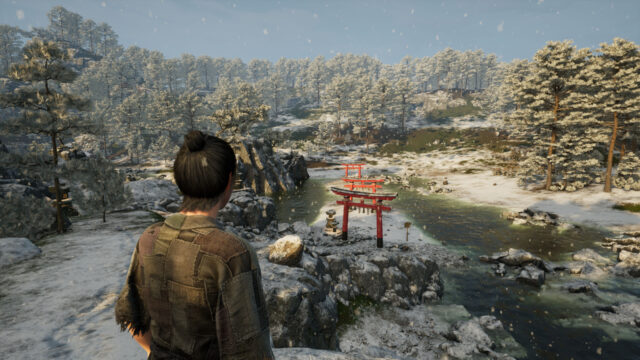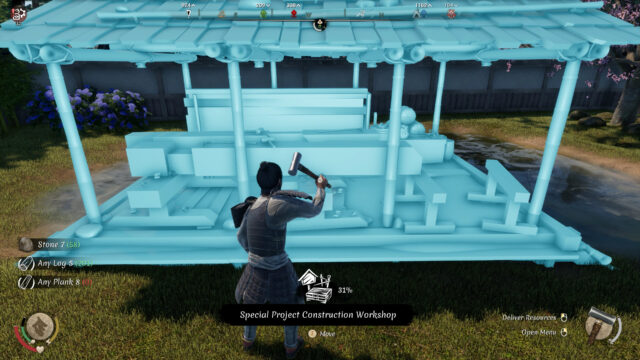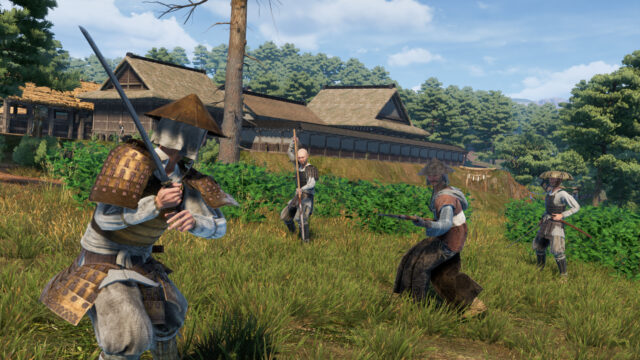Sengoku Dynasty Deep Look

Building up the settlement from a few shacks to a fully realised village complete with paths, walls, gates, and light sources is pleasing.
Toplitz Productions Dynasty series has given players the chance to transport themselves to historical locations and build up their own lives and settlements. One such title in the series is Superkami’s Sengoku Dynasty, which puts players in feudal Japan. Originally releasing for PC last November after a bit over a year in Early Access, this game is now making its console debut. It’s a game with an appreciable amount of depth and breadth, giving players plenty to do, but could perhaps benefit from a bit more structure at times.
Sengoku Dynasty doesn’t waste time dumping players into their new role. Players control a refugee fleeing warfare and hoping to find the legendary Peasant Kingdom. After surviving a wreck, they wake up in a region of Japan next to a ruined village. Spotting it as a potential location to start anew, they set to work building up a village of their own, creating homes and jobs for fellow refugees escaping their own dire situations.

Sengoku Dynasty produces some lovely environments.
The game is very light on active narrative; there is an overarching set of quests to give players targets and objectives, but otherwise the game is effectively free-form and allows players to go at their own pace. Most NPCs are there to either join the village ranks or point them towards new objectives and things to unlock, or generic looters and raiders. There may be some further depth as the campaign progresses, but the opening dozen or so hours are light on giving any real characterisation to any of its people.
Instead, the game’s main appeal comes from the process of developing and evolving the player’s village. Players are given free reign over the design of their settlements, and can place down buildings, paths, walls, decorations, and so forth wherever they wish. Any recruited refugees need to be assigned a bed before they assist. Meanwhile, any production facilities such as fields, a woodcutter lodge, or a smelter, require assigning villagers to the job and, if necessary, relevant tools, resources, and storage. Players will also need to decide which of the available items each job is responsible for producing and their quantity, which will necessitate frequent checking as certain items cannot be produced in certain seasons. Anything produced by the villagers is placed into the village’s storage for use elsewhere or to meet the villagers’ needs.
Players will start off by finding most resources themselves. However, as the village population increases and the list of resources needed for both maintenance and progress increases, it quickly becomes much more efficient to focus more on the management for gathering most items and needs, and to instead largely intervene directly when needed. The heavy management element arguably provides the biggest challenge for the game on console; the controls and UI work well enough after getting used to them, but it still feels less efficient than having the full keyboard and mouse setup.

Players have free reign to design and place their villages.
Players will need to ensure that the village is kept happy by meeting its needs. This starts with just food and heating, but as the village grows, the list of needs grows to include additional elements like luxuries and security. Players can also unlock the ability to found multiple villages around the region, with other locations having access to other resources not available elsewhere. Crafting and gathering is largely straightforward, as long as players have the resources, tools, or facilities required, they can easily and quickly create anything they have available. Tools and weapons — especially the rudimentary ones craftable from the start — will deteriorate fairly quickly and need to be replaced.
Combat is fairly standard fare for the survival genre. Players can wield a variety of weapons, such as a spear, bow, knife, and so forth, and will engage with both wildlife and hostile humans. Players have two different attack types with melee weapons, and will need to carefully aim ranged weaponry. In addition to health, players will also need to maintain their hunger levels, as well as handle potential issues like the cold or rain, though appropriate clothing can readily solve this.
There is a pleasing mixture of ways to unlock new items, buildings, crafting options, and so forth. Some are unlocked by raising the dynasty level through crafting and recruiting while others can be unlocked by obtaining specific items, unlocking certain perks through the player character’s growth system, or liberating specific areas by fulfilling listed objectives on the map. The player character gains experience for one of four skill trees by undertaking appropriate actions, earning points to spend on various perks within the trees.

Combat is standard survival fare.
A recent Bushido update, included in the console version, also adds raids, though the customiseable settings give players good control over what sort of threats and dangers they will have to deal with. There is no death, unless players actively choose to retire their character and take over as their offspring; instead, being knocked out simply results in waking up back at home with a loss of food and money. There is a sense that some elements could be fleshed out more, such as having more interactions with villagers, but there’s still plenty packed into the game.
Sengoku Dynasty’s environments are lovely. The hills, streams, and wildlife make for a very nice location to spend time in. Building up the settlement from a few shacks to a fully realised village complete with paths, walls, gates, and light sources is pleasing. However, while the game does a good job of showing their activities, things are let down by the dearth of variety in the character models, with many of the villagers looking exactly the same. The game’s sound is best described as functional; it provides the necessary alerts and background without impressing in any way, and the game is notably lacking in voice acting.
Sengoku Dynasty is a solid simulation title. It gives players plenty to do as they go about building up their own villages from scratch and gives them a very pleasing environment to do it in. While there will be those hoping for more of a guided approach or more of a narrative focus, and the console UI may not quite offer the same level of responsiveness and control of the PC version, it by and large works well. Even if some aspects might not be as fleshed out as they could be, there’s still a big game here that will engage its fans for many hours.
Disclosure: This article is based on a copy of the game provided by the publisher.
The post Sengoku Dynasty Deep Look appeared first on RPGamer.



